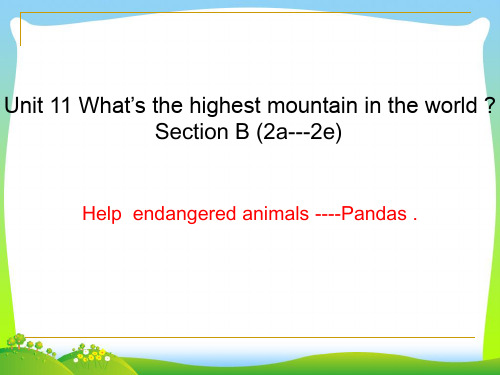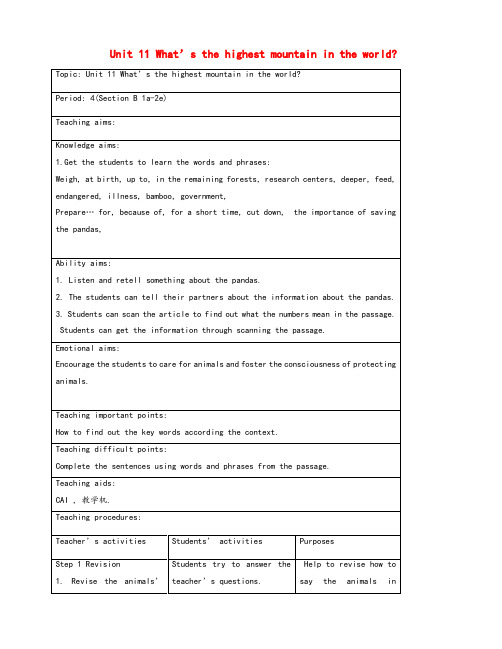鲁教版九年级英语unit11 Reading
- 格式:ppt
- 大小:1.92 MB
- 文档页数:15





鲁教版英语九年Unit 11 What’s the highest mountn in the world Section B 3a-3b 教学设计一. 教材分析鲁教版英语九年级Unit 11主要讨论了世界上最高的山——珠穆朗玛峰。
本节课将重点教授Section B 3a-3b部分,内容涉及到关于珠穆朗玛峰的简介以及攀登者的经历。
教材以真实的图片和生动的描述展示了珠穆朗玛峰的壮丽景象,使学生能够在学习语言的同时,增长见识,开阔眼界。
二. 学情分析九年级的学生已经掌握了基本的英语语法和词汇,具备一定的阅读理解能力。
他们对世界地理和自然景观充满好奇心,对于攀登珠穆朗玛峰这样具有挑战性的活动也有一定的兴趣。
然而,由于年龄和生活经验的限制,他们对珠穆朗玛峰的了解可能较为片面,需要通过本节课的学习来丰富和拓展。
三. 教学目标1.知识目标:学生能够掌握关于珠穆朗玛峰的基本信息,了解攀登者的经历,提高阅读理解能力。
2.能力目标:学生能够运用所学词汇和语法,进行简单的交流和讨论。
3.情感目标:培养学生对自然景观的敬畏之心,对攀登者的勇敢和坚持表示敬佩。
四. 教学重难点1.重点:学生能够理解并运用所学词汇和语法进行交流。
2.难点:学生能够理解文章深层含义,对攀登珠穆朗玛峰的挑战有更深入的认识。
五. 教学方法采用任务型教学法,让学生在完成具体任务的过程中,提高英语运用能力。
同时,运用情境教学法,创设相关情境,让学生在真实的环境中感受和体验语言。
六. 教学准备1.教师准备:提前阅读教材,熟悉教学内容,准备相关教学材料。
2.学生准备:预习教材,对珠穆朗玛峰有一定的了解。
七. 教学过程1.导入(5分钟)利用图片和问题引导学生谈论自然景观,导入新课。
例如:“你们知道世界上最高的山是哪座吗?”2.呈现(10分钟)教师快速阅读文章,边读边板书关键词,如:Mount Everest, highest mountn in the world, climbers, challenge等。

鲁教版英语九年Unit 11 What’s the highest mountn in the world Section B 2a-2e 教学设计一. 教材分析鲁教版英语九年Unit 11主要介绍了世界上最高的山——珠穆朗玛峰。
本节课的重点是让学生能够掌握描述珠穆朗玛峰高度和位置的词汇和句型,如the highest, in the world, located in, the Himalayas等。
同时,通过阅读和听力活动,提高学生的阅读理解和听力技能。
二. 学情分析九年一班的学生英语水平普遍较好,大多数学生对描述地理知识的英语词汇和句型有一定的了解。
他们在课堂上积极参与,乐于进行小组合作学习。
然而,部分学生对一些专业术语的掌握尚有不足,需要老师在课堂上进行重点讲解和辅导。
三. 教学目标1.学生能够掌握描述珠穆朗玛峰高度和位置的词汇和句型。
2.学生能够通过阅读和听力活动,了解珠穆朗玛峰的相关知识。
3.学生能够提高阅读理解和听力技能。
4.学生能够运用所学知识进行口头和书面表达。
四. 教学重难点1.重点:描述珠穆朗玛峰高度和位置的词汇和句型。
2.难点:对一些专业术语的理解和运用。
五. 教学方法1.任务型教学法:通过完成各种任务,激发学生的学习兴趣,提高学生的参与度。
2.情境教学法:创设情境,让学生在真实的语境中学习和运用英语。
3.交际型教学法:鼓励学生进行小组合作学习,提高学生的交际能力。
六. 教学准备1.准备相关的图片和视频资料,以便在课堂上进行展示。
2.准备练习题,用于课后巩固所学知识。
3.准备教学PPT,以便在课堂上进行教学。
七. 教学过程1.导入(5分钟)利用图片和视频资料,向学生介绍珠穆朗玛峰,激发学生的兴趣。
然后,引导学生用英语描述珠穆朗玛峰的高度和位置。
2.呈现(10分钟)老师向学生展示教材中的图片,引导学生用英语描述图片内容。
同时,讲解相关的词汇和句型,如the highest, in the world, located in, the Himalayas 等。
Unit11 What's the highest mountain in the world Section B教案 2一、Teaching Aims and Demands1. Knowledge Objects(1)Key VocabularyBamboo, research, awake, excitement, illness, adult, remain, wild, government, prepare…for, run over, fall over, die from, and cut down(2)Target Language1) Adult pandas spend more than 12 hours a day eating about 10 kilos of bamboo.2) Scientists say there are now fewer than 2.000 pandas living in the remaining forests.3) We all hope that in the future there will be a lot more pandas than now.2. Ability Objects(1)Be able to find specific information and understand the passage by scanning.(2)Learn to talk about the facts of pandas by using the numeral and the comparisons of adj. and adv.3. Moral ObjectsEncourage students to take an active part in protecting animals.二、Teaching Key Points(1) Be able to scan the passage and train Ss’ reading and understanding ability.(2) Learn and master the language points and the understanding of the passage.三、Teaching Difficult PointsLearn and master scanning strategy四、Teaching ProceduresStep 1 Reading1. Pre-readingTalk about panda in your class. Use these words to help you.big, bamboo, zoo, popular, cute, black and white,Sichuan, famous, endangered, beautiful, forest, protect,2. Reading guidance: scanningThis means moving your eyes quickly down the page to find specific information.3. Reading tasks1. 2b Scan the article to find out what these numbers mean:10, 12, 200, 20002. 2c Scan the article again and write short answers to the questions.1. What is Lin Wei’s job?2. What do the baby pandas eat for breakfast?3. What do adult pandas eat?4. Why are pandas endangered?5. What is one way of saving pandas?Key: 1. A panda keeper. 2. Milk. 3. Bamboos.4. Less forest for pandas to live.5. Teaching children.3. 2d Complete the sentences using words and phrases from the passage.1. The panda _______ at the Chengdu Research Base are awake very early in themorning to _______ breakfast for the baby pandas.2. Adult pandas do not have babies very ____, and some of the babies only live for ashort time because of _______.3. Another reason for fewer and fewer pandas is because people are cutting down______ so pandas have fewer places to live.4. A special program in Chengdu teaches _______ about why pandas are __________and how to save them.5. The __________ is also helping to save the pandas. It’s __________ more trees tomake more homes for the pandas.Keys: keepers, prepare, often, illnesses, trees, children, endangered,Chinese government, necessary to plant2e Discuss what other ways you think children can help to save the pandas.Step 3 SummaryTalk about how to protect pandas.。
鲁教版英语九年Unit 11 What’s the highest mountn in the world Section B 3a-selfcheck 说课稿一. 教材分析鲁教版英语九年级Unit 11的主题是“What’s the highest mountn in the world?”,本文主要介绍了世界上最高的山——珠穆朗玛峰。
通过学习本节课,学生可以了解珠穆朗玛峰的高度、位置以及与它相关的知识。
同时,学生还可以学习到如何描述物体的高度、宽度和长度。
本节课的内容与学生的日常生活紧密相连,有利于激发他们的学习兴趣。
二. 学情分析九年级的学生已经具备了一定的英语基础,能够听、说、读、写简单的英语句子。
但是,对于描述物体尺寸的词汇和句型,部分学生可能还不太熟悉。
因此,在教学过程中,需要关注这部分学生的学习需求,给予他们更多的关爱和帮助。
此外,学生对于世界地理知识的了解各不相同,教师需要在课堂上充分调动学生的积极性,引导他们共同探讨。
三. 说教学目标1.知识目标:学生能够掌握描述物体尺寸的词汇和句型,如“What’s thehighest mountn in the world? It’s… meters high. It’s… meters wide and… meters long.”。
2.能力目标:学生能够运用所学知识描述现实生活中的人或物,提高英语实际运用能力。
3.情感目标:通过学习本节课,学生能够培养对地理知识的兴趣,增强团队协作意识。
四. 说教学重难点1.重点:描述物体尺寸的词汇和句型。
2.难点:如何运用所学知识描述现实生活中的人或物。
五. 说教学方法与手段1.教学方法:采用任务型教学法,让学生在实践中学习、巩固知识。
2.教学手段:利用多媒体课件、地图、图片等辅助教学,提高学生的学习兴趣。
六. 说教学过程1.导入:教师展示珠穆朗玛峰的图片,引导学生谈论世界上最高的山。
2.新课呈现:教师通过多媒体课件介绍珠穆朗玛峰的高度、位置等知识,引导学生学习描述物体尺寸的词汇和句型。